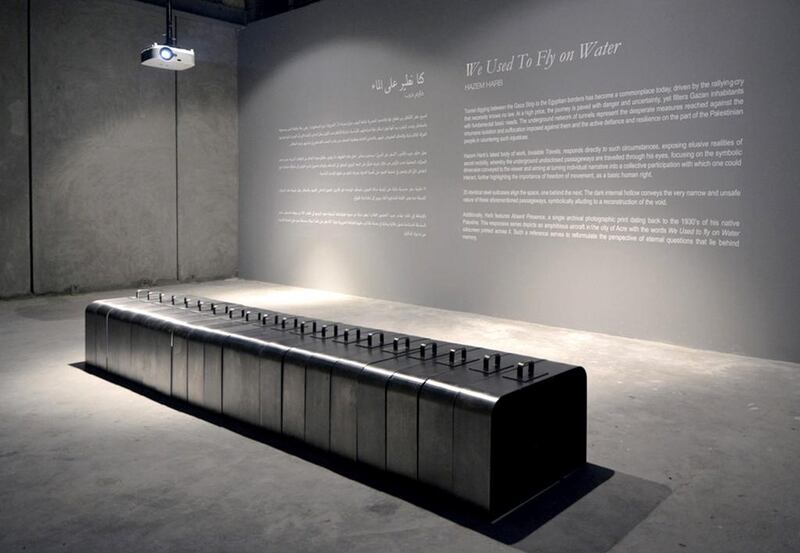As Hazem Harb offers me a seat in his studio, he absent-mindedly opens a sketch book. I let out a gasp as I see the page: it is the first sketch for Harb's installation We Used to Fly on Water, which made its debut at Athr Gallery in Jeddah earlier this year and was the piece de resistance in the gallery's booth at Art Dubai in March.
Consisting of 20 empty, stainless-steel suitcases forming a tunnel, the piece is a strong commentary on the Palestinian situation. It represents a nation of people forced to constantly travel because they cannot return home, forced to crawl through tunnels to cross borders. It was part of a larger collection that featured images of a Palestinian water plane and highlighted their technological advances before occupation.
In the sketch book, next to the pencil drawing of the installation, are scribbled sentences that are only partly legible; the words “hidden”, “underground”, “invisible” and “darkness” are underlined.
It is a fascinating glimpse into what was to become the backbone of one of Harb’s most interesting works.
“This is where the idea was born,” says the artist, looking around the studio with a contemplative gaze. “This is where I think, so this is where every project begins.”
But after a little more questioning, I discover this is not strictly true. We are sitting in Harb’s home studio in his Dubai Marina apartment, but he is not always here. Much like the unidentified Palestinians in his installation, Harb is always on the move. He has been living in this apartment for only a year but plans to move soon. He is spending the summer in his semi-permanent home in Belluno, a small Italian village near the Austrian border. For him, this nomadic existence is normal.
“I am used to making my home as soon as I arrive anywhere,” he says. “It is because I cannot return to my country, so I never really feel free. My work is too connected to this concept.”
Born in 1980 in the Gaza Strip, Harb witnessed a great deal of conflict in his early years. His mother, a fashion stylist, introduced him to art through her sketches. When he was 12, he started attending art classes at the YMCA in Gaza City.
He finally left Gaza in 1999 to enrol for a fine arts degree at Nablus at An-Najah University in Palestine, but his plans were thwarted by the second intifada so he ended up back in Gaza and moved to Italy a few years later.
In 2004, Harb enrolled at the Academy of Fine Arts in Rome and graduated from The European Institute of Design in 2009.
Since then, his career has been gaining traction with a residency at the Delfina Foundation in London in 2011 and, last year, the British Museum in London acquired his photography series Beyond Memory.
Currently, his work is on show in the United Kingdom's Durham University. In October, he will exhibit at the Grand Palais in Paris.
When I visited, Harb had just finished a series of abstract geometric paintings for a solo show at Athr titled Al Baseera. The large scale canvases, filled with precise colour blocks and abstracted forms of Islamic patterns, reveal a marked shift in tone.
Al Baseera is derived from the Arabic word basar, which means to look as well as to see through something, whether an object, an event or an idea.
“[This series] came from a personal need to do something different,” Harb explains. “I had to get away from the idea of conflict because, honestly, there is no more space for the sadness inside of me. I am not just talking as a Palestinian but as a human being and an artist – our world is full of catastrophe.”
• For more, visit www.hazemharb.com
aseaman@thenational.ae










